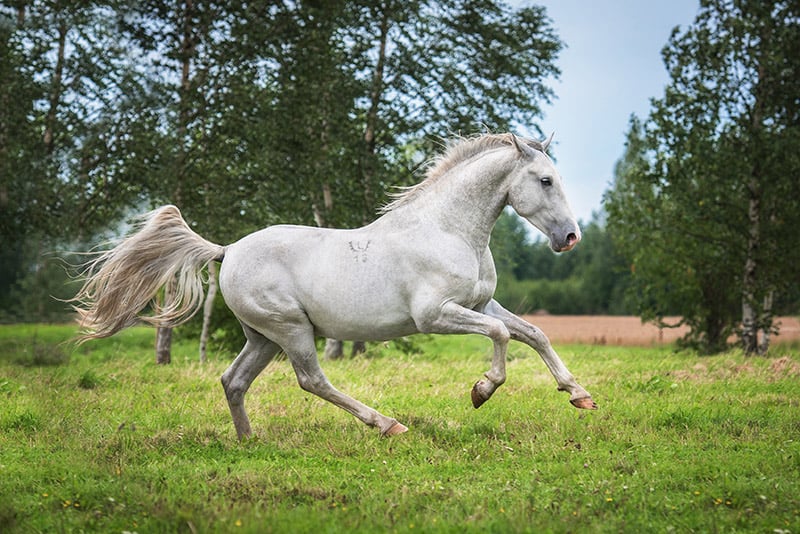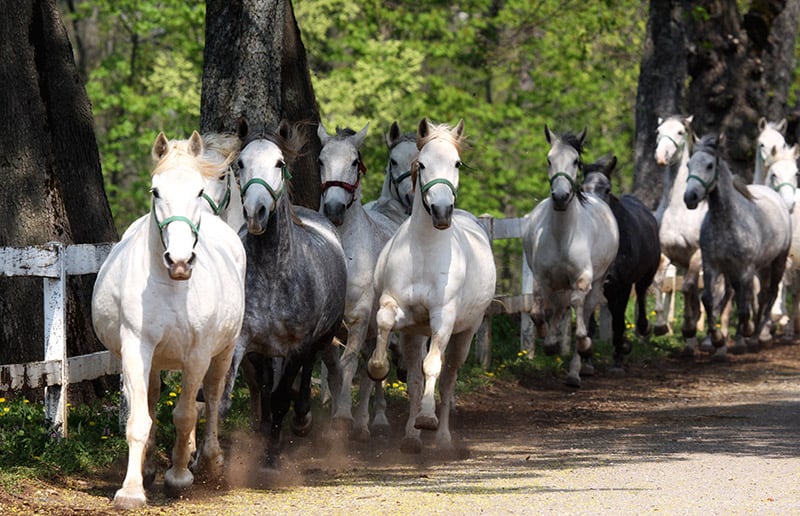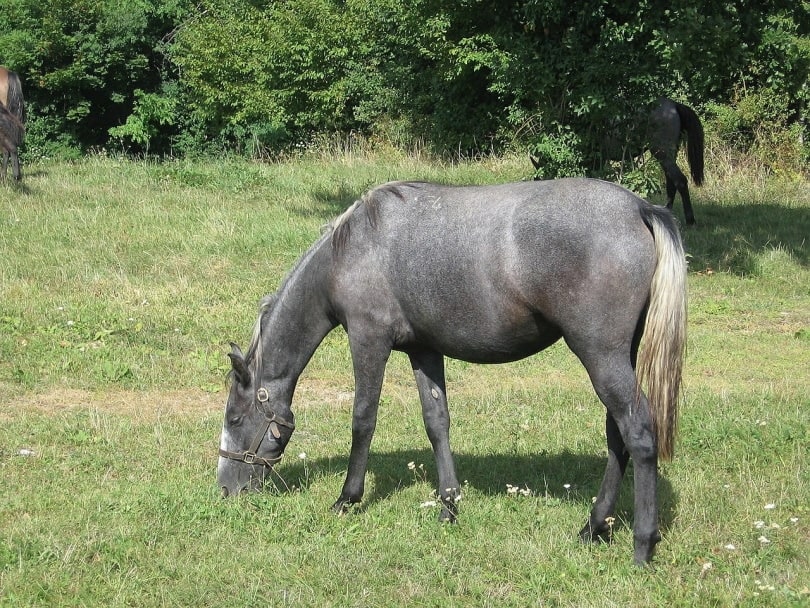The “World Famous” Lippizaner Stallions are an acclaimed spectacle worldwide and favorite family arena show!
The Lipizzaner is the most famous breed for haute ecole dressage. Haute Ecole is high level dressage movements where the horses leap off the ground. These High School jumps are popularly known as the ‘airs above the ground’. The Lipizzaners at the Spanish Riding School in Vienna are world renown for their beautiful ‘dances’. They are one of the few breeds, along with the Lusitano and Andalusian breeds, that are trained in these High Dressage movements.
The Lipizzaner shares its ancestry with the Andalusian and Lusitano breeds. Like them, the Lipizzan breed is also descended from Spanish horses that were imported to Slovenia from the Iberian Peninsula in the late 1500’s. The breed was founded by six Lipizzaner stallions from which all Lipizzaner horses are descended.
From their beginnings of a devoted and passionate breed development, to the present day, they have had a colorful history. They became nearly extinct during World War II. But because of their impressive performances, General Patton placed the horses under the protection of the United States until the end of the war, with only 250 Lipizzaners surviving. Today the breeding of Lipizzaners is highly concentrated at a few farms and registration is highly selective.
Scientific Classification
| Kingdom: | Animalia |
| Phylum: | Chordata |
| Class: | Mammalia |
| Order: | Perissodactyla |
| Family: | Equidae |
| Genus: | Equus |
| Species: | caballus |
Horse Breeds
The Lipizzaner is a light horse breed. Light horse breeds generally weigh under 1,500 pounds. They are typically used as riding horses for leisure and trail riding. Being agile and swift, many are also used on the racetrack, in the show ring, and for work on the ranch.
Light horses are grouped in a couple of different ways, one being the continent or country where they originated from. They are also grouped according to training, classified as either a stock type, hunter type, saddle type, or ‘other’. A body type is generally attributed to each class, with the ‘other’ classification being a bit of an odd ball. It includes those that are color breeds or those that may fit a body type of one of the training classes, but not be used for that type of training. The ‘other’ types can also include those that may fit into more than one of the type groups.
The horse class the Lipizzan fits into is the ‘other’ class.

Horse Backgrounds
The Lipizzaner is descended from Spanish horses that were imported to Slovenia from the Iberian Peninsula in the late 1500’s, giving it a shared ancestry with the Andalusian and Lusitano breeds. The Spanish horses were imported by the Archduke Charles II, who founded the Lipizza Stud in 1580, with the aim of creating a stock of grand horses for the court stables in Vienna. Other Spanish horse studs were also founded, the two most notable being the Piber Stud, near Graz, Austria, and the Kladruby Stud in the Czech Republic.
The Spanish Riding School in Vienna was founded eight years before the Lipizza Stud and had been using horses of Spanish descent from the outset. Horses from the Lipizza, Piber, and Kladruby Studs were selected to be used at the riding school, but over the years the horses from Lipizza came to be regarded as the most talented for the training of haute ecole or ‘the airs above the ground’ and they began to be viewed as their own breed.
The Lipizzaner breed was founded by six stallions. All Lipizzaner horses are descended from these six Lipizzaner stallions:
- Pluto, a Spanish horse from the Royal Danish Court Stud
- Conversano and Neapolitano, who were Neapolitans
- Maestoso, a Kladruber bred at the Hungarian stud at Mezohegyes
- Favory, bred at the Kaldruby Stud
- Siglavy, who is believed to be an Arab.
The Lipizza Stud selectively bred white horses, believing that this was the most suitable color for grand horses who were to be ridden by nobility. Therefore, Lipizzaners are predominantly white, but all other colors do exist.
The modern Spanish Riding School Lipizzaners are bred at the Piber Stud and less than ten a year are selected to begin training at the school. They begin training at four years old, and it then takes four to six years before they can perform the highest movements of haute ecole dressage and join the School Quadrille.
Lipizzaners are also bred throughout Hungary, Romania, the Czech Republic, and Slovakia, but they maintain the six stallion lines upon which the breed was founded.
The Second World War almost caused the extinction of the Lipizzaner breed, but under the leadership of Alois Podhajsky, the then director of the Spanish Riding School, the breed was preserved. The horses at the Spanish Riding School had to be evacuated to St. Martin’s in northern Austria to escape the bomb raids hitting Vienna. Even then, the lack of food for the horses and the attempts by refugees to steal them for meat made their survival difficult.
In 1945, the U.S. Army took control of St. Martin’s. After the Lipizzaners gave an impressive performance, General Patton of the 2nd U.S. Calvary, who had competed with Podhajsky in the Olympic Games prior to the war, placed the horses under the protection of the United States until the end of the war. Patton also issued orders to save Lipizzaners that had been moved from the Piber Stud to Hostau by the Germans, and a raid was conducted behind Soviet lines to save the horses.
Only 250 Lipizzaners survived the war, but the breed was saved. In 2005, the Spanish Riding School celebrated the 60th anniversary of Patton’s rescue by touring the United States.

Description
Since the breeding of Lipizzaners is highly concentrated at a few farms and registration is highly selective, the breed has a very specific type. Most Lipizzaners stand a little over 15 hands high and they are compact and muscular. Their very powerful hindquarters allow them to do the difficult haute ecole dressage movements, including the “airs above the ground”.
The head is often slightly dished, which is reminiscent of an Arabian, but they can also have the Spanish convex profile. The head is set high on a well-muscled, arched neck. They have a short back, but are very deep through the girth. The cannon bones are short and the legs have good bone.
The Lipizzaner’s gaits are powerful and elastic, with high action instead of low and long gaits like the warmblood breeds seen in many dressage competitions. Lipizzaners are naturally balanced and well-known for excellent trainability and intelligence.
Horse Care and Feeding
The Lipizzaner’s white coat requires constant grooming to keep it clean. Ideally they should be exercised on a regular schedule and turned out in a paddock daily.
Horse Training and Activities
Lipizzaners are world renown for their talent as dressage horses and their performance of the haute ecole movements. They are also used as carriage horses and general riding horses.

Common Health Problems
The light coat of the Lipizzaner makes them susceptible to melanomas because the skin is more exposed to the sun and they should be checked regularly for bumps. Melanomas are a problem in any light-colored horses due to the lack of pigmentation in the skin. They tend to form in areas where the hair is thin, such as on the muzzle and around the tail.
Availability
Though the Lipizzaner breed is found in Europe, the United States, and Canada, it is relatively rare, with only 3,000 horses registered worldwide.
Featured Image Credit: PeterT, Pixabay
